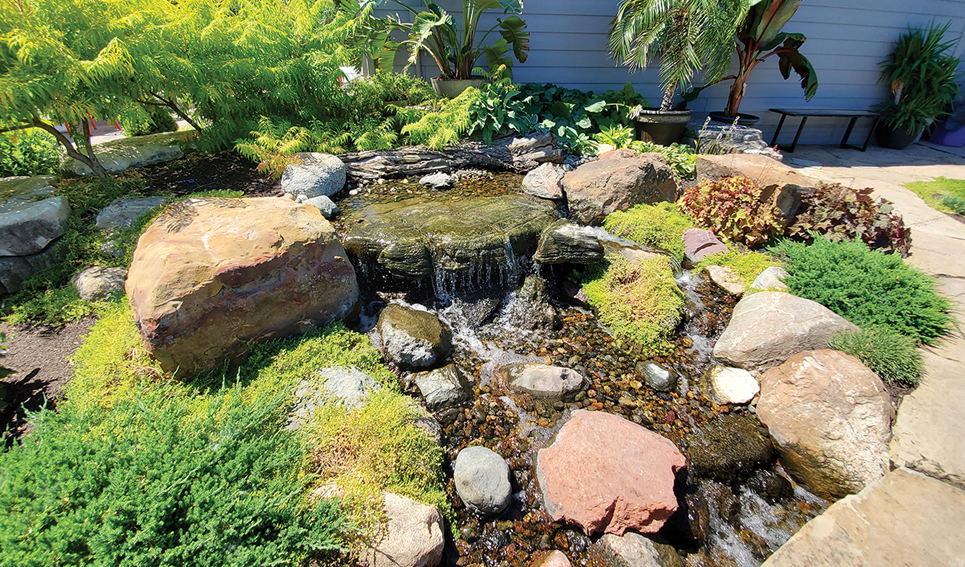
Things to Consider Before You Start
Most pond builders who have built even one pond have probably wondered, “If only I had checked ‘X,’ I would have saved so much time and money!” I have gone through this thought process so many times myself that I have created a checklist of things to consider before I even take my shovel out of the garage. This list is intended to save both time and money.
Planning
Do all your planning before you begin to dig. Once the soil structure is disturbed, it is difficult to recreate the stability of that soil. If settling occurs under edgings, waterfalls and streams, big problems may await you in the future. In areas where soil has been brought in to bring up the grade, it will need to be compacted well. If this cannot be done satisfactorily, or if the soil is very sandy and not stable, a concrete footing may need to be installed.
Also think about what might have been buried as trash in the area of the future pond. Quality underlayment is a must for all ponds, especially in this type of situation.
Also, is some sort of permit needed? Are there any underground utilities in the area where you plan to dig? Be mindful of all water, telephone, electric, cable, gas, sewer or septic lines. In most areas, there is local contact number to help locate many of these utilities. For homeowner-installed utilities (septic fields or electric service in the landscape that was installed by a contracted electrician), you will need to hire someone to locate these.Also bear in mind any potential safety issues. Will children have access to the pond? Is fencing necessary? What about liability insurance? Are there any potential hazards that should be avoided? A large population of deer, raccoons or other critters in the area could lead to issues later on.
Siting

Where will the pond be located on the site? Consider the view, sun exposure and trees. Contrary to what you may think, do not build in a low spot unless you make provisions to divert runoff during heavy rains.
What about access to water and electricity? The cost of providing power close to the water feature will need to be calculated. For a water source, well water is OK. City water that has been dechlorinated is OK. Even rainwater (off the roof, for example) is OK, but do not use sump-pump water or water from a nearby creek or lake. This type of water can contain high levels of nutrients that can create conditions for an algae bloom. Fish parasites can be in this water also. Also, too much rainwater flowing in all at once from a roof can completely flush out a pond. A 10-to-20-percent addition is OK, but make provisions to divert roof water away from the pond during heavy rains.
Along those lines, where will water drain when the pond is emptied or overflows? Will this create a problem for you or a neighbor?
Designing

What is the design style of the present landscaping — formal or informal? Would a symmetrical (formal) or irregular (informal) pond shape look better? It is important in most small landscapes to match the style of the pond to the existing style of the landscaping. Make a drawing to scale, and then lay out the outline of the pond in the yard with a garden hose or something similar. Look at it for a few days. Watch how the sun hits it at different times of the day and look at it from different locations in the yard and house.
What about water plants and fish? The answer to this question affects many of the other considerations, like potential predator issues, filtration and depth. The beauty of blooming waterlilies and the excitement of watching fish can far outweigh the extra effort of adding these elements, which create more of an active ecosystem.
Related Article >> Incorporating Drones into Water Feature Design and Construction
Drones and Water Feature Design

What type of edging will reflect your garden style? I’ve written about edges here before. Your edge design may incorporate ways to keep grass clippings and other yard debris out of the water. For example, if wood chips are to be used close to the edge of the pond, choose the heavier types, as they are less likely to blow into the water. Consider the width and depth of in-pond ledges. A minimum 18-inch width should be used. (If space allows, 24 inches is better.) A depth of 12 inches for the in-pond ledge is standard for all ponds.
The shape of the pond should be simple and open. Overly fussy or complicated designs tend to create problems. The entry point for pond maintenance needs to be planned out. In those areas, I would incorporate flat stones on the edge with no more than 12 inches of depth. In larger ponds, at least two entry areas should be included in the design.
Building
What materials will you use to build the pond? Consider all the pros and cons of whatever you are using — concrete, PVC, EPDM, fiberglass or even a preformed pond.
Could water from heavy rains, sprinkler systems or runoff from lawns contaminate the pond? The pond’s edge should be a minimum of 2 to 4 inches above grade depending on your landscape. This small rise will divert surface runoff from entering the pond. Remember, it could need a steeper rise in grade depending on the landscape. A river can develop even in a flat landscape during a 5-to-10-inch rain. Fish, liner and plants can be washed out, and organic matter of all sorts can be washed in. Bog gardens will normally work fine in low spots.

What about filtration? Mechanical prefilters, biological, chemical, phyto (plant), UV and settling chambers are all types to think about. Take into account the number and types of fish in the pond. Would a bottom drain be a good choice?
As you consider depth of the pond, make sure you know how shallow the water table is. The pressure from groundwater can cause liner to lift and bubble. A hydrostatic drain can be installed to drain the groundwater away if needed.
In terms of depth, generally, bigger is better. A larger pond’s temperatures and chemical makeup are more stable. Build as large a pond as space, budget and time will allow. (Most people wish they had built a bigger pond after the fact.) Recall that maintenance sometimes requires getting into the pond. Considering the height of chest waders or hip waders is important when the water is cold and swimming is not an option.

A minimum depth of 18 to 30 inches is needed to overwinter hardy waterlilies in areas where icing can occur. A deeper depth is needed for larger fish like koi. You can still have points in the pond that are shallow enough for access, but make sure you still have a deeper depth in the center of the pond to accommodate the large fish.
If you want a waterfall or some type of moving water, it’s especially important to plan ahead. For each 100 gallons per hour pumped down a waterfall, the flow will be approximately ½ inch deep and 1 inch wide, or ¼ inch deep and 2 inches wide. If neighbors are close by, consider their reaction to the sound of a waterfall. A gentle waterfall most everybody would welcome; however, some may consider a tall, large-volume waterfall just a bunch of noise.
Do you need to add a timer on the waterfall to shut it off at night? While this saves electricity, your biological filter and the aeration may be negatively affected by turning off the water pump. Using two pumps with one turned off at night with a timer works great on water gardens and fishponds. Timers are especially useful on water features that are not associated with a water garden. The stream depth and design should be mapped out so that there is a deep-enough water retention pocket to contain the stonework and water. If the pocket is not deep enough, leaks will be probable. This pocket is located under the feature and acts as a bib to ensure that all the water is returned to the pond.
Consider With Caution
Don’t listen to those who say it’s so simple to build a pond. “All you have to do is dig a hole, lay down flexible liner and pile rocks on top of it, right?”
In reality, the considerations of planning, siting, designing and finally constructing the project as a whole need to be worked out before you even ponder driving a shovel into the soil. The extra time you take to follow these considerations could save you disappointment, time and money. The reward? Many years of enjoyment!




Hello Jamie,
This is really a nice article. These are the best things to consider before starting a pond. Thanks for sharing these best points with us. Please keep sharing more because you shared very Informative stuff every time.